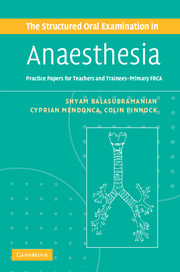SOE 1
Published online by Cambridge University Press: 21 January 2010
Summary
Key topics: reflex arc, pituitary, ventilation-perfusion
Q1 Muscle spindles and the reflex arc
Can you tell me the components of the reflex arc?
The reflex arc is the basic unit of integrated reflex activity. It consists of a sense organ, afferent neuron, one or more synapses, an efferent neuron, and an effector.
What is the Bell-Magendie law?
In the spinal cord, dorsal roots are sensory (afferent neurons enter the spinal cord through the dorsal horn) and ventral roots are motor (efferents).
What is a monosynaptic reflex?
This describes the reflex occurring in a monosynaptic reflex arc. There is one synapse between afferent and efferent neurons. Example: knee jerk.
What is a polysynaptic reflex?
A reflex with more than one synapse. Example: withdrawal reflex.
What is the mechanism for the knee jerk?
Basically, it is a stretch reflex of quadriceps femoris (stimulus: tap on the tendon that stretches the tendon; response: muscle contraction).
What is the structure of a muscle spindle?
The muscle spindle consists of a group of muscle fibres enclosed in a connective tissue capsule, which is distinct from the rest of the muscle (embryonal in character and having less striations). These fibres are called intrafusal fibres. Extrafusal fibres are the regular contractile fibres of the muscle.
There are two types of muscle fibres:
Nuclear bag fibre (containing many nuclei).
Nuclear chain fibre (thinner and shorter).
- Type
- Chapter
- Information
- The Structured Oral Examination in AnaesthesiaPractice Papers for Teachers and Trainees, pp. 1 - 23Publisher: Cambridge University PressPrint publication year: 2006



